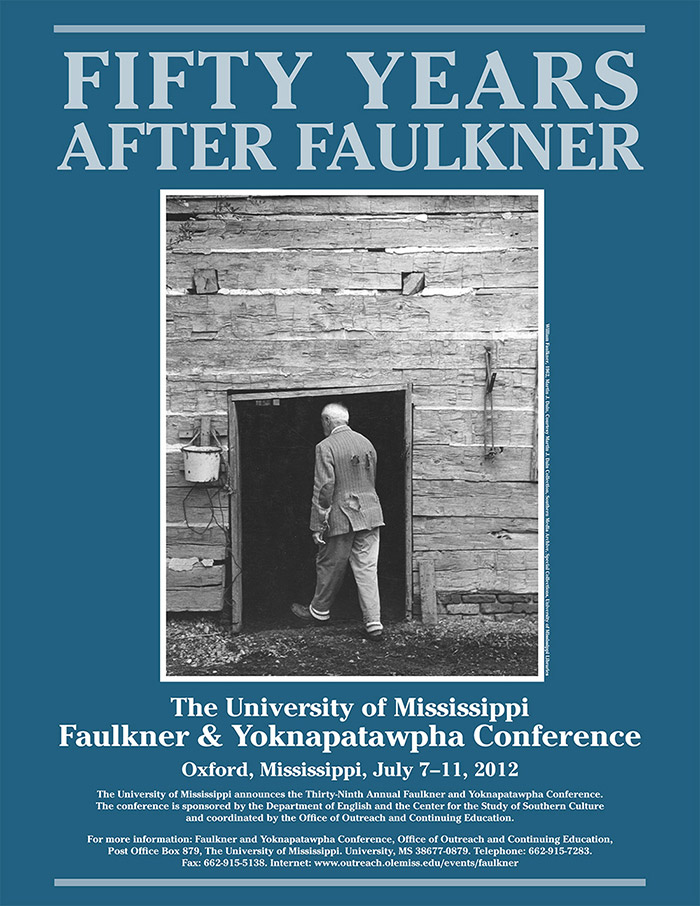
Panel. Faulkner in Other Media
Location
Yerby Center Auditorium
Start Date
11-7-2012 9:30 AM
Description
- Loom of her father's dreams: Ruin and Restoration, or Building Faulkner's Literary Place / Edward Clough, University of East Anglia
My PhD thesis examines Faulkner’s use of the Southern plantation mansion as physical space, symbolic site, and literary-linguistic device; this paper looks at those mansions more narrowly, via theories of ruin and restoration. Beginning with an overview that maps their role in Faulkner’s fiction, I offer illustrative case-studies from The Hamlet and The Mansion, centering on Flem Snopes’s social ascent. Drawing out the narrative, material, and philosophical implications of Linda Snopes’s perception of the mansion as “loom of her father’s dreams”, I consider how Faulkner uses mansions to explore Southern power politics and identity politics; to reflect on the dilemmas of cultural historical revisionism; and to explore the role of the Southern ruin in generating literary and socio-cultural narratives. - Lending A Voice: Transembodied Media Acoustics in Faulkner’s Absalom, Absalom! / Julie Beth Napolin, Eugene Lang College
This paper argues against the persistent elision of media in Faulkner studies to show that, rather than being absent from Yoknapatawpha, communications technology is ubiquitously present within it. The issue is not the presence of phonography and the radio as motifs or metaphors, but rather the ways of thinking about sound and voice opened up by audio, which I argue Faulkner to have been actively responding to in moments when it appears to be most absent. That absence speaks to the profound force of mediation both to function and dissolve. An account of this physical force contributes to a new reading of voices in Absalom, Absalom!, particularly the voice of Rosa. I ask how the function of Rosa’s voice is to mediate, but also how she thereby articulates Faulkner’s larger philosophy of individual and collective memory. This paper brings not only “old” new media to bear upon Rosa as one of the most poorly understood (and misheard) voices of his body of work, but also the digital archive as it can address our own remembrance and commemoration of the novel at the audible level. - The “Gesamtkunstwerk” Connection: Lynd Ward’s Woodcut Illustrations of William Faulkner’s Poem “This Earth” / Erik Redling, Martin Luther Universität Wittenberg
Guided by the notion of the ‘Gesamtkunstwerk,’ Faulkner not only created Art Nouveau illustrations à la Aubrey Beardsley for his early poetry, but also paid careful attention to typography, the color of ink, and the overall design of the covers in order to produce works of art in which all aspects contributed to a rich aesthetic experience. Abandoning this concept in the mid 1920s, Faulkner’s interest in the notion of the ‘Gesamtkunstwerk’ was rekindled when he became aware of Ward’s work in 1932. In this paper, I will explore the similarities between Faulkner’s early poetry and Ward’s woodcut illustrations of Faulkner’s poem “This Earth.”
Relational Format
Conference proceeding
Recommended Citation
Clough, Edward; Napolin, Julie Beth; and Redling, Erik, "Panel. Faulkner in Other Media" (2012). Faulkner and Yoknapatawpha Conference. 61.
https://egrove.olemiss.edu/fy/2012/schedule/61
COinS
Jul 11th, 9:30 AM
Panel. Faulkner in Other Media
Yerby Center Auditorium
- Loom of her father's dreams: Ruin and Restoration, or Building Faulkner's Literary Place / Edward Clough, University of East Anglia
My PhD thesis examines Faulkner’s use of the Southern plantation mansion as physical space, symbolic site, and literary-linguistic device; this paper looks at those mansions more narrowly, via theories of ruin and restoration. Beginning with an overview that maps their role in Faulkner’s fiction, I offer illustrative case-studies from The Hamlet and The Mansion, centering on Flem Snopes’s social ascent. Drawing out the narrative, material, and philosophical implications of Linda Snopes’s perception of the mansion as “loom of her father’s dreams”, I consider how Faulkner uses mansions to explore Southern power politics and identity politics; to reflect on the dilemmas of cultural historical revisionism; and to explore the role of the Southern ruin in generating literary and socio-cultural narratives. - Lending A Voice: Transembodied Media Acoustics in Faulkner’s Absalom, Absalom! / Julie Beth Napolin, Eugene Lang College
This paper argues against the persistent elision of media in Faulkner studies to show that, rather than being absent from Yoknapatawpha, communications technology is ubiquitously present within it. The issue is not the presence of phonography and the radio as motifs or metaphors, but rather the ways of thinking about sound and voice opened up by audio, which I argue Faulkner to have been actively responding to in moments when it appears to be most absent. That absence speaks to the profound force of mediation both to function and dissolve. An account of this physical force contributes to a new reading of voices in Absalom, Absalom!, particularly the voice of Rosa. I ask how the function of Rosa’s voice is to mediate, but also how she thereby articulates Faulkner’s larger philosophy of individual and collective memory. This paper brings not only “old” new media to bear upon Rosa as one of the most poorly understood (and misheard) voices of his body of work, but also the digital archive as it can address our own remembrance and commemoration of the novel at the audible level. - The “Gesamtkunstwerk” Connection: Lynd Ward’s Woodcut Illustrations of William Faulkner’s Poem “This Earth” / Erik Redling, Martin Luther Universität Wittenberg
Guided by the notion of the ‘Gesamtkunstwerk,’ Faulkner not only created Art Nouveau illustrations à la Aubrey Beardsley for his early poetry, but also paid careful attention to typography, the color of ink, and the overall design of the covers in order to produce works of art in which all aspects contributed to a rich aesthetic experience. Abandoning this concept in the mid 1920s, Faulkner’s interest in the notion of the ‘Gesamtkunstwerk’ was rekindled when he became aware of Ward’s work in 1932. In this paper, I will explore the similarities between Faulkner’s early poetry and Ward’s woodcut illustrations of Faulkner’s poem “This Earth.”

